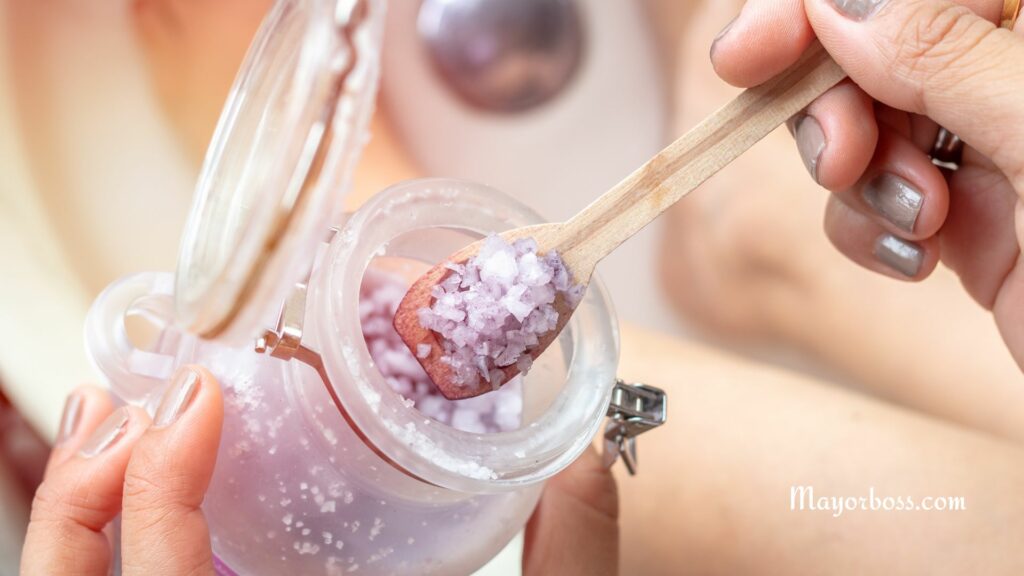8 Benefits of Epsom Salt That Will Make You Take a Bath
An Epsom salt bath is more than just a relaxing soak; it offers a range of health benefits. From soothing sore muscles to improving skin health, Epsom salts have magnesium and sulfate that your body can absorb through the skin. The bath can also help with stress relief and detoxification and even ease constipation.

What Are Epsom Salts?
You might wonder what makes Epsom salts different from your regular table salt. Well, Epsom salts are actually mineral compounds made of magnesium and sulfate. These elements have various health benefits, which can be absorbed through your skin when you take a bath.
What Are The Benefits Of Taking an Epsom Salts Bath?
Ease Sore Muscles
One of the most common reasons people turn to Epsom salt baths is for relief from sore muscles. The magnesium in the salts helps your muscles relax. After a tough workout or a long day on your feet, soaking in an Epsom salts bath can help your body recover faster.
Boosts Magnesium Levels
Magnesium is a workhorse in your body, taking part in over 300 biochemical reactions. Yet, according to healthcare professionals, many people don’t get enough of it. Fortunately, an Epsom salts bath can help replenish your magnesium levels, providing an alternative to eating magnesium-rich foods like spinach or nuts. That’s because Epsom salt is absorbed through the skin.
Improve Skin Health
If you struggle with skin conditions like acne, eczema, or psoriasis, this bath could be a game-changer for you. The sulfates present in Epsom salts help to eliminate toxins, allowing more nutrients to enter your skin cells. Plus, magnesium’s anti-inflammatory properties can tone down redness and irritation.
Stress Relief
Stress is something we all deal with. The magnesium in Epsom salts can help produce serotonin, a mood-boosting hormone. This makes you feel calmer and more relaxed. So, the next time you’re feeling overwhelmed, consider soaking in an Epsom salt bath to wind down.
Detoxification
The term “detox” gets thrown around a lot these days. When it comes to Epsom salt baths, the detoxification process is about helping your body get rid of harmful substances. The magnesium and sulfate in the salts help flush toxins out of your cells, giving your body’s natural detoxification process a little boost.
Offers Relief for Ingrown Toenails and Swollen Feet
Dealing with an ingrown toenail or swollen feet? Soaking your feet in an Epsom salt bath can help. The magnesium works to reduce inflammation, while the warm water improves circulation. This combo can relieve pain and help your body heal faster. Plus, the salts can act as a natural exfoliant, helping to remove dead skin cells around the affected area.
Alleviates Symptoms of Fibromyalgia
If you or someone you know suffers from fibromyalgia, Epsom salts could provide some much-needed relief. Magnesium relaxes muscles and improves nerve function, helping to alleviate the pain and fatigue associated with this condition.
Soothes Sunburn Pain and Redness
Got a little too much sun? An Epsom salt bath might be just the remedy you need. The anti-inflammatory properties of magnesium can help soothe your sunburn, reducing both redness and pain. The sulfates also aid in skin repair, so you’ll be back to feeling like yourself sooner.
According to Experts
According to medical professionals, the magnesium and sulfate in Epsom salts can indeed be absorbed through your skin. However, while many people find relief and benefits from Epsom salt baths, the scientific evidence is still limited. So, while it’s generally considered safe to soak in an Epsom salts bath, it’s always a good idea to talk to a healthcare provider if you have specific health concerns.
How to Take an Epsom Salts Bath
Taking an Epsom salt bath is a simple process, but doing it the right way can maximize its benefits. Here’s a step-by-step guide on how to make the most out of your Epsom salt bath experience.
Gather Your Supplies
Before you start running the water, make sure you’ve got everything you need. You’ll require:
- Epsom salts (roughly 2 cups for a standard-size bathtub)
- A bathtub filled with warm water
- A towel
- Optional: essential oils, like lavender or eucalyptus, for added relaxation

Fill the Tub With Warm Water
Start by filling your bathtub with warm water. The water shouldn’t be too hot; aim for a comfortable temperature that you can easily soak in. The warm water not only feels good but also helps your skin absorb the Epsom salts more effectively.
Add the Epsom Salts
As the tub fills, go ahead and add the Epsom salts. Use about 2 cups for a standard-size bathtub. If you’re focusing on just your feet, a smaller basin will do, and you can use less salt. Make sure to stir the water to help dissolve the salts fully.

Time to Soak
Once the tub is ready, ease yourself into the water. Aim to soak for at least 20 minutes to get the full benefits of the Epsom salts. This is the perfect time to practice deep breathing, listen to calming music, or simply enjoy the peaceful moment.
Focus on Problem Areas
Got sore muscles or an aching back? Use this time to focus on those problem areas. You can even rub some of the dissolved Epsom salts directly onto your skin for a more targeted approach.
Keep Hydrated
While you’re soaking up all those good minerals, don’t forget to keep hydrated. Have a glass of water nearby to sip on. After all, you’re detoxing and replenishing, and hydration plays a key role in both.
Time to Get Out
After 20 to 30 minutes, you’ll likely feel pretty relaxed and maybe even a bit sleepy. That’s your cue to get out of the tub. Drain the water and carefully stand up; take it slow, as the salts and warm water can make you feel a bit lightheaded.
Pat Yourself Dry
Grab your towel and gently pat yourself dry. Avoid rubbing your skin, as you want to leave a bit of the salt residue to continue absorbing into your skin.
Moisturize
Finish off by applying a moisturizer to lock in the benefits and keep your skin soft. Choose a gentle, natural lotion to maximize the effects of your Epsom salt bath.
And there you have it! You’ve just had an optimal Epsom salt bath experience. Whether you’re looking to relax, relieve pain, or improve your skin, this simple routine is your go-to for making the most of those magical salts.
Frequently Asked Questions About Epsom Salts Baths
How Often Should I Take an Epsom Salts Bath?
You might be eager to jump into this soothing experience, but moderation is key. Most experts suggest taking an Epsom salt bath up to two or three times a week. However, if you have specific medical conditions or are pregnant, consult your healthcare provider for personalized advice.
Can Epsom Salt baths Help with Arthritis Pain?
Good news for those dealing with arthritis: Epsom salt baths can offer some relief. The magnesium in Epsom salts acts as a natural muscle relaxant, which can reduce inflammation and ease pain. Nevertheless, while it can offer temporary relief, it’s not a cure for arthritis.
Are Epsom Salts Baths Safe for Kids?
You might wonder if Epsom salt baths are okay for the little ones. Generally speaking, they are considered safe for children. Just make sure to adjust the amount of Epsom salts to match their smaller size. A half cup should be enough for a small bathtub. Also, keep an eye on them to ensure they don’t drink the bathwater!
Can I Take an Epsom Salts Bath if I Have a Skin Condition?
People with skin conditions like eczema or psoriasis often ask if Epsom salt baths are a good idea. The answer usually depends on the individual. For some, the mineral-rich bath can alleviate symptoms. Yet, for others, it might exacerbate the condition. To be on the safe side, consult your healthcare provider before taking that plunge.
Do Epsom Salts Expire?
If you’ve found an old bag of Epsom salts hiding in your cabinet, you might wonder if they’re still good to use. The good news is that Epsom salts don’t expire or go bad. However, they can clump together over time, especially if exposed to moisture. Just break up the clumps, and you’re good to go!






